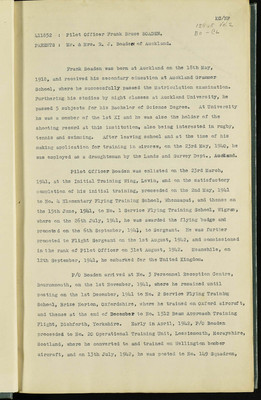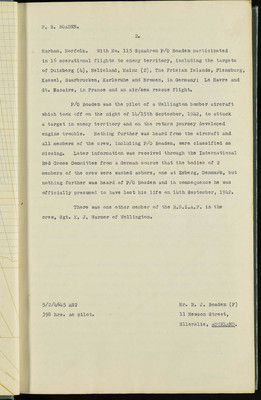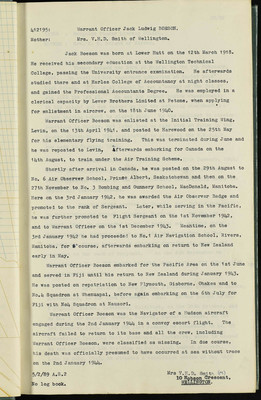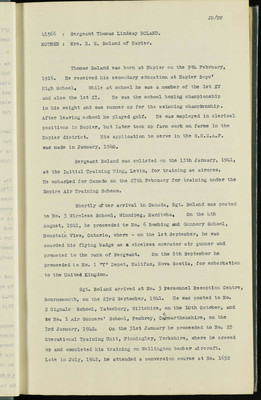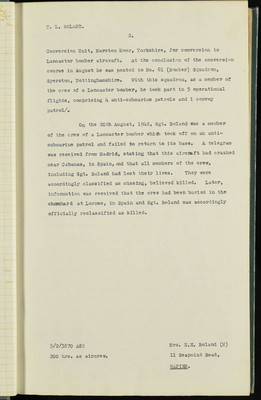Pages
1
KC/NF 12848 - Vol. 2 BO – CL
411852 : Pilot Officer Frank Bruce BOADEN.
PARENTS : Mr. & Mrs. R. J. Boaden of Auckland.
Frank Boaden was born at Auckland on the 18th May, 1918, and received his secondary education at Auckland Grammer School, where he successfully passed the Matriculation examination. Furthering his studies by night classes at Auckland University, he passed 5 subjects for his Bachelor of Science Degree. At University he was a member of the 1st XI and he was also the holder of the shooting record at this institution, also being interested in rugby, tennis and swimming. After leaving school and at the time of his making application for training in aircrew, on the 23rd May, 1940, he was employed as a draughtsman by the Lands and Survey Dept., Auckland.
Pilot Officer Boaden was enlisted on the 23rd March, 1941, at the Initial Training Wing, Levin, and on the satisfactory completion of his initial training, proceeding on the 2nd May, 1941 to No. 4 Elementary Flying Training School, Whenuapsi, and thence on the 15th June, 1941, to No. 1 Service Flying Training School, Wigram, where on the 26th July, 1941, he was awarded the flying badge and promoted on the 6th September, 1941, to Sergeant. He was further promoted to Flight Sergeant on the 1st August, 1942, and commissioned in the rank of Pilot Officer on 31st August, 1942. Meanwhile, on 12th September, 1941, he embarked for the United Kingdom.
P/O Boaden arrived at No. 3 Personnel Reception Centre, Bournemouth, on the 1st November, 1941, where he remained until posting on the 1st December, 1941 to No. 2 Service Flying Training School, Brize Norton, Oxfordshire, where he trained on Oxford aircraft, and thence at the end of December to No. 1512 Beam Approach Training Flight, Dishforth, Yorkshire. Early in April, 1942, P/O Boaden proceeded to No. 20 Operational Training Unit, Lossiemouth, Morayshire, Scotland, where he converted to and trained on Wellington bomber aircraft, and on the 13th July, 1942, he was posted to No. 149 Squadron,
2
F. B. BOADEN.
2.
Marham, Norfolk. With No. 115 Squadron P/O Boaden participated in 16 operational flights to enemy territory, including the targets of Duisberg (4), Helioland, Mainz (2), the Frisian Islands, Flensbug, Kassel, Saarbrucken, Karlscruhe and Bremen, in Germany; Le Havre and St. Nazaire, in France and an air/sea rescue flight.
P/O Boaden was the pilot of a Wellington bomber aircarft which took off on the night of 14/15th September, 1942, to attack a target in enemy territory and on the return journey developed engine trouble. Nothing futher was heard from the aircraft and all members of the crew/ including P/O Boaden, were classified as missing. Later information was received through the International Red Cross Commitee from a German source that the bodies of 2 members of the crew were washed ashore, one at Esberg, Denmark, but nothing further was heard of P/O Boaden and in consequence he was officially presumed to have lost his life on 14th September, 1942.
There was one other member of the R.N.Z.A.F. in the crew, Sgt. K.J. Warner of Wellington.
3
Jack Boeson was born at Lower Hutt on the 12th March 1918. He received his secondary education at the Wellington Technical College, passing the University entrance examination. He afterwards studied there and at Harles College of Accountancy at night classes, and gained the Professional Accountants Degree. He was employed in a clerical capacity by Lever Brothers Limited at Petone, when applying for enlistment in aircrew, on the 18th June 1940.
Warrant Officer Boeson was enlisted at the Initial Training Wing, Levin, on the 13th April 1941, and posted to Harewood on the 25th May for his elementary flying training. This was terminated during June and he was reposted to Levin, afterwards embarking for Canada on the 14th August, to train under the Air Training Scheme.
Shortly after arrival in Canada, he was posted on the 29th August to No. 6 Air Observer School, Prince Albert, Saskatchewan and then on the 27th November to No. 3 Bombing and Gunnery School, MacDonald, Manitoba. Here on the 3rd January 1942, he was awarded the Air Observer Badge and promoted to the rank of Sergeant. Later, while serving in the Pacific, he was further promoted to Flight Sergeant on the 1st November 1942, and to Warrant Officer on the 1st December 1943. Meantime, on the 3rd January 1942 he had proceeded to No.1 Air Navigation School, Rivers, Manitoba, for a course, afterwards embarking on return to New Zealand early in May.
Warrant Officer Boeson embarked for the Pacific Area on the 1st June and served in Fiji until his return to New Zealand during January 1943. He was posted on repatriation to New Plymouth, Gisborne, Ohakea and to No.4 Squadron at Whenuapai, before again embarking on the 6th July for Fiji with No4 Squadron at Nausori.
Warrant Officer Boeson was the Navigator of a Hudson aircraft engaged during the 2nd January 1944 in a convoy escort flight. The aircraft failed to return to its base and all the crew, including Warrant Officer Boeson, were classified as missing. In due course, his death was officially presumed to have occurred at sea without trace on the 2nd January 1944.
4
JN/NF
Thomas Boland was born at Napier on the 9th February, 1916. He received his secondary education at Napier Boys' High School. While at school, he was a member of the 1st XV and also the 1st XI. He was the school boxing championship in his weight and was runner up for the swimming championship. After leaving school he played golf. He was employed in clerical positions in Napier, but later took up farm work on farms in the Napier district. His application to serve in the R.N.Z.A.F. was made in January, 1940.
Sergeant Boland was enlisted on the 13th January, 1941, at the Initial Training Wing, Levin, for training as aircrew. He embarked for Canada on the 27th February for training under the Empire Air Training Scheme.
Shortly after arrival in Canada, Sgt. Boland was posted to No. 3 Wireless School, Winnipeg, Manitoba. On the 4th August, 1941, he proceeded to No. 6 Bombing and Gunnery School, Mountain View, Ontario, where - on the 1st September, he was awarded his flying badge as a wireless operator air gunner and promoted to the rank of Sergeant. On the 8th September he proceeded to No. 1 "Y" Depot, Halifax, Nova Scotia, for embarkation to the United Kingdom.
Sgt. Boland arrived at No. 3 Personnel Reception Centre, Bournemouth, on the 23rd September, 1941. He was posted to No. 2 Signals School, Yatesbury, Wiltshire on the 10th October, and to No. 1 Air Gunners' School, Pembrey, Caermarthenshire, on the 3rd January, 1942. On the 31st January he proceeded to No. 25 Operational Training Unit, Finningley, Yorkshire, where he crewed up and completed his training on Wellington bomber aircraft. Late in July, 1942, he attended a conversion course at No. 1652
5
T. L. BOLAND.
2.
Conversion Unit, Marston Moor, Yorkshire, for conversion to Lancaster bomber aircraft. At the conclusion of the conversion course in August he was posted to No. 61 (Bomber) Squadron, Syerston, Nottinghamshire. With this squadron, as a member of the crew of a Lancaster bomber, he took part in 5 operational flights, comprising 4 anti-submarine patrols and 1 convoy patrol/.
On the 20th August, 1942, Sgt. Boland was a member of the crew of a Lancaster bomber which took off on an antisubmarine patrol and failed to return to its base. A telegram was received from Madrid, stating that this aircraft had crashed near Cabanas, in Spain, and that all members of the crew, including Sgt. Boland had lost their lives. They were accordingly classified as missing, believed killed. Later, information was received that the crew had been buried in the churchard at Lornes, in Spain and Sgt. Boland was accordingly officially reclassified as killed.
